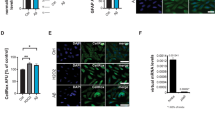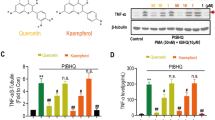Abstract
Protocatechuic acid (PA), a major metabolite of anthocyanins, has been reported to possess antioxidant and anti-inflammatory activities. However, the effects of PA on LPS-induced inflammatory responses in microglia have not been reported. The aim of this study was to investigate the anti-inflammatory effects and molecular mechanisms of PA on LPS-stimulated BV2 microglia. The production of inflammatory mediators TNF-α, IL-6, IL-1β, and PGE2 were detected by ELISA. TLR4, NF-κB and MAPKs activation were detected by western blotting. Our results demonstrated that PA dose-dependently inhibited LPS-induced TNF-α, IL-6, IL-1β, and PGE2 production. In addition, PA suppressed LPS-induced TLR4 expression, NF-κB and MAPKs activation, which resulted in the inhibition of inflammatory mediators. In conclusion, these results suggested that PA exhibited anti-inflammatory effects on LPS-stimulated BV2 microglia and the mechanisms were involved in the inhibition of TLR4-mediated NF-κB and MAPKs signaling pathways.




Similar content being viewed by others
References
Griffiths M, Neal JW, Gasque P (2007) Innate immunity and protective neuroinflammation: new emphasis on the role of neuroimmune regulatory proteins. Int Rev Neurobiol 82:29–55
Zhou X, He X, Ren Y (2014) Function of microglia and macrophages in secondary damage after spinal cord injury. Neural Regen Res 9:1787–1795
Pan XD, Chen XC, Zhu YG, Zhang J, Huang TW, Chen LM, Ye QY, Huang HP (2008) Neuroprotective role of tripchlorolide on inflammatory neurotoxicity induced by lipopolysaccharide-activated microglia. Biochem Pharmacol 76:362–372
Ock J, Kim S, Yi KY, Kim NJ, Han HS, Cho JY, Suk K (2010) A novel anti-neuroinflammatory pyridylimidazole compound KR-31360. Biochem Pharmacol 79:596–609
Merighi S, Gessi S, Varani K, Fazzi D, Stefanelli A, Borea PA (2013) Morphine mediates a proinflammatory phenotype via mu-opioid receptor-PKCvarepsilon-Akt-ERK1/2 signaling pathway in activated microglial cells. Biochem Pharmacol 86:487–496
Park J, Min JS, Kim B, Chae UB, Yun JW, Choi MS, Kong IK, Chang KT, Lee DS (2014) Mitochondrial ROS govern the LPS-induced pro-inflammatory response in microglia cells by regulating MAPK and NF-kappaB pathways. Neurosci Lett 584C:191–196
Velagapudi R, Aderogba M, Olajide OA (2014) Tiliroside, a dietary glycosidic flavonoid, inhibits TRAF-6/NF-kappaB/p38-mediated neuroinflammation in activated BV2 microglia. Biochim Biophys Acta 1840:3311–3319
Pisanu A, Lecca D, Mulas G, Wardas J, Simbula G, Spiga S, Carta AR (2014) Dynamic changes in pro- and anti-inflammatory cytokines in microglia after PPAR-gamma agonist neuroprotective treatment in the MPTPp mouse model of progressive Parkinson’s disease. Neurobiol Dis 71:280–291
Walker DG, Whetzel AM, Lue LF (2014) Expression of suppressor of cytokine signaling genes in human elderly and Alzheimer’s disease brains and human microglia. Neuroscience pii: S0306-4522(14)00803-3. doi:10.1016/j.neuroscience.2014.09.052
Tsao SM, Hsia TC, Yin MC (2014) Protocatechuic acid inhibits lung cancer cells by modulating FAK, MAPK, and NF-kappaB pathways. Nutr Cancer 66:1331–1341
Vari R, D’Archivio M, Filesi C, Carotenuto S, Scazzocchio B, Santangelo C, Giovannini C, Masella R (2011) Protocatechuic acid induces antioxidant/detoxifying enzyme expression through JNK-mediated Nrf2 activation in murine macrophages. J Nutr Biochem 22:409–417
Min SW, Ryu SN, Kim DH (2010) Anti-inflammatory effects of black rice, cyanidin-3-O-beta-D-glycoside, and its metabolites, cyanidin and protocatechuic acid. Int Immunopharmacol 10:959–966
Del Corno M, Varano B, Scazzocchio B, Filesi C, Masella R, Gessani S (2014) Protocatechuic acid inhibits human dendritic cell functional activation: role of PPARgamma up-modulation. Immunobiology 219:416–424
Wei M, Chu X, Jiang L, Yang X, Cai Q, Zheng C, Ci X, Guan M, Liu J, Deng X (2012) Protocatechuic acid attenuates lipolysaccharide-induced acute lung injury. Inflammation 35:1169–1178
Yan JJ, Jung JS, Hong YJ, Moon YS, Suh HW, Kim YH, Yun-Choi HS, Song DK (2004) Protective effect of protocatechuic acid isopropyl ester against murine models of sepsis: inhibition of TNF-alpha and nitric oxide production and augmentation of IL-10. Biol Pharm Bull 27:2024–2027
Lin WL, Hsieh YJ, Chou FP, Wang CJ, Cheng MT, Tseng TH (2003) Hibiscus protocatechuic acid inhibits lipopolysaccharide-induced rat hepatic damage. Arch Toxicol 77:42–47
Thummuri D, Jeengar MK, Shrivastava S, Nemani H, Ramavat RN, Chaudhari P, Naidu VG (2015) Thymoquinone prevents RANKL-induced osteoclastogenesis activation and osteolysis in an in vivo model of inflammation by suppressing NF-KB and MAPK Signalling. Pharmacol Res 99:63–73
Wang W, Zhou PH, Xu CG, Zhou XJ, Hu W, Zhang J (2015) Baicalein attenuates renal fibrosis by inhibiting inflammation via down-regulating NF-kappaB and MAPK signal pathways. J Mol Histol 46:283–290
Nakagawa Y, Chiba K (2014) Role of microglial M1/M2 polarization in relapse and remission of psychiatric disorders and diseases. Pharmaceuticals 7:1028–1048
Dai XJ, Li N, Yu L, Chen ZY, Hua R, Qin X, Zhang YM (2014) Activation of BV2 microglia by lipopolysaccharide triggers an inflammatory reaction in PC12 cell apoptosis through a toll-like receptor 4-dependent pathway. Cell Stress Chaperones 20:321–331
Cheng W, Li Y, Hou X, Bai B, Li F, Ding F, Ma J, Zhang N, Shen Y, Wang Y (2015) Determining the neuroprotective effects of dextromethorphan in lipopolysaccharidestimulated BV2 microglia. Mol Med Rep 11:1132–1138
Ishihara Y, Itoh K, Ishida A, Yamazaki T (2014) Selective estrogen-receptor modulators suppress microglial activation and neuronal cell death via an estrogen receptor-dependent pathway. J Steroid Biochem Mol Biol 145C:85–93
Dec E, Rana P, Katheria V, Dec R, Khare M, Nalbandian A, Leu SY, Radom-Aizik S, Llewellyn K, BenMohamed L, Zaldivar F, Kimonis V (2014) Cytokine profiling in patients with VCP-associated disease. Clin Transl Sci 7:29–32
Zhang J, Guo J, Zhao X, Chen Z, Wang G, Liu A, Wang Q, Zhou W, Xu Y, Wang C (2013) Phosphodiesterase-5 inhibitor sildenafil prevents neuroinflammation, lowers beta-amyloid levels and improves cognitive performance in APP/PS1 transgenic mice. Behav Brain Res 250:230–237
Pangestuti R, Vo TS, Ngo DH, Kim SK (2013) Fucoxanthin ameliorates inflammation and oxidative reponses in microglia. J Agric Food Chem 61:3876–3883
Cai L, Wang Z, Meyer JM, Ji A, van der Westhuyzen DR (2012) Macrophage SR-BI regulates LPS-induced pro-inflammatory signaling in mice and isolated macrophages. J Lipid Res 53:1472–1481
Zhu X, Owen JS, Wilson MD, Li H, Griffiths GL, Thomas MJ, Hiltbold EM, Fessler MB, Parks JS (2010) Macrophage ABCA1 reduces MyD88-dependent Toll-like receptor trafficking to lipid rafts by reduction of lipid raft cholesterol. J Lipid Res 51:3196–3206
Harvey KA, Walker CL, Xu Z, Whitley P, Pavlina TM, Hise M, Zaloga GP, Siddiqui RA (2010) Oleic acid inhibits stearic acid-induced inhibition of cell growth and pro-inflammatory responses in human aortic endothelial cells. J Lipid Res 51:3470–3480
Fu Y, Wei Z, Zhou E, Zhang N, Yang Z (2014) Cyanidin-3-O-beta-glucoside inhibits lipopolysaccharide-induced inflammatory response in mouse mastitis model. J Lipid Res 55:1111–1119
Zhao ZZ, Tang XF, Zhao XH, Zhang MH, Zhang WJ, Hou SH, Yuan WF, Zhang HF, Shi LJ, Jia H, Liang L, Lai Z, Gao JF, Zhang KY, Fu L, Chen W (2014) Tylvalosin exhibits anti-inflammatory property and attenuates acute lung injury in different models possibly through suppression of NF-kappa B activation. Biochem Pharmacol 90:73–87
Chuang YF, Yang HY, Ko TL, Hsu YF, Sheu JR, Ou G, Hsu MJ (2014) Valproic acid suppresses lipopolysaccharide-induced cyclooxygenase-2 expression via MKP-1 in murine brain microvascular endothelial cells. Biochem Pharmacol 88:372–383
German OL, Monaco S, Agnolazza DL, Rotstein NP, Politi LE (2013) Retinoid X receptor activation is essential for docosahexaenoic acid protection of retina photoreceptors. J Lipid Res 54:2236–2246
Ouyang ZX, Zhai ZJ, Li HW, Liu XQ, Qu XH, Li XN, Fan QM, Tang TT, Qin A, Dai KR (2014) Hypericin suppresses osteoclast formation and wear particle-induced osteolysis via modulating ERK signalling pathway. Biochem Pharmacol 90:276–287
Tang YB, Jacobi A, Vater C, Zou XN, Stiehler M (2014) Salvianolic acid B protects human endothelial progenitor cells against oxidative stress-mediated dysfunction by modulating Akt/mTOR/4EBP1, p38 MAPK/ATF2, and ERK1/2 signaling pathways. Biochem Pharmacol 90:34–49
Acknowledgments
This study was supported by Grants from the National Key disciplines Fund of the Ministry of Health of the People’s Republic of China, the Foundation of Tianjin Science and Technology Committee (12ZCDZSY17700, 14JCZDJC35600), National Key Technology Support Program 2014BAI04B02.
Conflict of interest
All authors declare that they have no conflict of interest.
Author information
Authors and Affiliations
Corresponding author
Rights and permissions
About this article
Cite this article
Wang, Hy., Wang, H., Wang, Jh. et al. Protocatechuic Acid Inhibits Inflammatory Responses in LPS-Stimulated BV2 Microglia via NF-κB and MAPKs Signaling Pathways. Neurochem Res 40, 1655–1660 (2015). https://doi.org/10.1007/s11064-015-1646-6
Received:
Revised:
Accepted:
Published:
Issue Date:
DOI: https://doi.org/10.1007/s11064-015-1646-6




